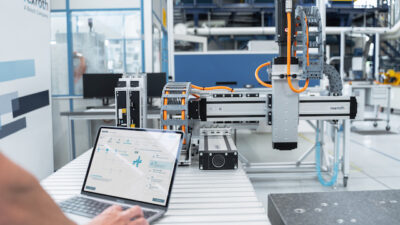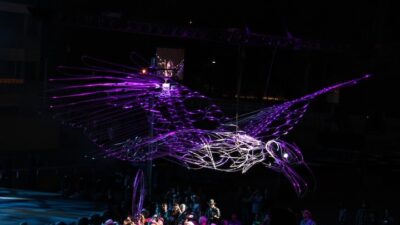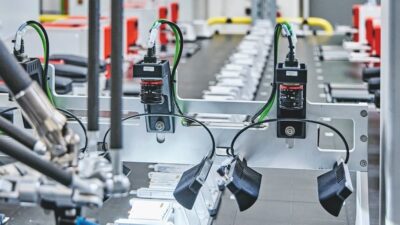They span the gamut of sizes from "micro drives" that virtually fit into your shirt pocket to large system drives and medium-voltage units. However, ac adjustable-speed drives have some attributes in common: increasingly capable control of ac induction motors, including torque control in some models, and inherent benefit of energy savings for many applications.
They span the gamut of sizes from ‘micro drives’ that virtually fit into your shirt pocket to large system drives and medium-voltage units. However, ac adjustable-speed drives have some attributes in common: increasingly capable control of ac induction motors, including torque control in some models, and inherent benefit of energy savings for many applications.
To gauge trends in this product sector, Control Engineering and Reed Research Group—both part of Reed Business Information ( www.reedbusiness.com )—asked subscribers about their views and preferences on ac adjustable-speed drives (ASDs) via an e-mail survey. Selected results presented here are based on 146 full responses received in July 2005 from subscribers who evaluate, specify, recommend, install, and/or purchase ac drives. Among these, 56% do so for in-plant requirements, 21% for OEM (resale), and 23% for both functions.
Some constants, some changes
Pumps, fans, and blowers remain the most popular application of ASDs, reported by 27% of respondents (versus 50% in 2003), indicating more diversity in this years’ survey. Other top applications were food/beverage processing and assembly/conveyor lines with 12% and 10% of usage, respectively. Material handling equipment, which placed third in 2003, was one of the least mentioned applications in 2005.
Open-loop (V/Hz) control continues as the clear choice for 79% of respondents, (versus 84% in 2003), with encoderless-vector control holding second spot at 41% (40% in 2003) and closed-loop vector control at 38% (37% in 2003).
However, significant changes occurred from the last survey in features that users value the most for selecting their drives. In part, this is explained by changes in the makeup of respondents (geographic distribution), larger drive sizes specified, and in new capital expenditures over the time period. The top four drive functional features rated as ‘very important’ were enclosure type (NEMA 12) by 38% of those surveyed, preset speeds (34%), NEMA 4 enclosure (33%), and CE mark/other certification (30%). In the 2003 survey, these features rated much lower; instead, simple controls/setup, convenient operator interface, and pricing were top features desired.
As for performance features , medium-voltage operation (2.3 kV and up) was the most important, according to 54% of respondents—followed by control of multiple motors from one drive (43%), ability to control synchronous as well as induction motors (37%), and four-quadrant operation (33%). These features likewise rated low in the prior survey.
Adjustable-speed drives are still largely used standalone, as 83% of respondents attest; but 42% say their ASDs are networked. (Both could be checked if applicable.) Among those currently applying networked drives, 79% use 4-20 mA. However, results suggest Ethernet TCP/IP (currently 67%) will be the most widely used network over the next year. DeviceNet came in third at 61%. Higher usage in the next 12 months also is forecast for Ethernet Powerlink, currently favored by 19% of respondents.
ASD purchases are on the rise. Fifty-six percent say their ac drive purchases will increase in the coming year—compared to 42% in 2003 (24% in 2002)—while only 3% (6% in 2003) foresee declining purchases. Survey results indicate that in the past 12 months, each respondent purchased 25 ASDs, spending $46,500, on average.
Shifting choices
Charles Manning, product marketing manager at Omron Electronics LLC, suggests that changes in users’ drive feature preferences—enclosures, preset speeds, and certifications—may indicate interest from OEMs and integrators. ‘Perhaps more importantly, CE certification seems to indicate that domestic companies are exporting their products overseas,’ he says. ‘The earlier responses seem to indicate a lower comfort level with drive operation, so responders may be reflecting more confidence, as drives become more common.’
Manning also notes that despite high levels of technology offered, purchasers have started to perceive ac drives as commodity products, making manufacturers work harder to provide differentiating features from their competitors. ‘I expect in the future there will be drives that ‘plug and play’ when connected to industrial networks and… [can] contact a local or factory technician when problems occur,’ he explains.
Shifting ASD market needs are likewise noted at Schneider Electric. While OEMs benefit from today’s easier-to-use products that provide good value, customers are choosing drives based on other features that help maximize their potential and expand the geographical market, according to Ivan Spronk, product line manager for ac drives. ‘Product certification markings are becoming more important as the industry becomes an increasingly global marketplace and OEMs look beyond the U.S. for market opportunities,’ he says. For example, the CE mark is crucial to sell equipment in Europe, and other markings (NOM and CCC) serve the same role for growing markets, such as Mexico and China.
As ac drives see more duty in dusty and washdown environments, enclosure type (NEMA 12 and 4) is becoming increasingly important. Applications may include industrial processes not previously using ac drives, notes Spronk. Moreover, a ‘continuing trend with OEMs is to mount all controls associated with a piece of equipment directly on the machine instead of adjacent to or in a separate room,’ he says.
AC drives continue to expand into new applications, according to Schneider Electric. With improved motor control algorithms they continue to displace applications previously served by dc drives, and recent passage of the U.S. Energy Bill will likely spur their use in HVAC applications. ‘In industry, we see increased use of communication networks as a means to reduce installation and maintenance costs and manage information,’ Spronk adds.
Simplicity, reliability
Rich Mintz, product manager at SEW-Eurodrive, has seen a lot of interest in robust housings and preset speeds with the company’s high-performance Movidrive. In his experience, drive simplicity and reliability still count high with customers—especially for installation and maintenance. Mintz concurs with survey results that many ac drive installations remain standalone. ‘Smaller OEMs may not want a fancy fieldbus-connected drive, for now,’ he says. ‘Users want simplicity and product consistency.’ This extends to one software tool, whether for small or large drive sizes, especially for machine diagnostics and operator interface tasks, adds Mintz.
According to AutomationDirect, today’s adjustable-speed drive users look for improved low-end speed performance, precise torque/speed control, and increased reliability. ‘With these features readily available, a requirement for stable integrated four-quadrant operation could be the deciding differentiator among end-users,’ says Tom Matyas, drives, motors and motion product manager. Four-quadrant operation often uses bulky external regenerative units or inefficient dynamic braking circuits. That’s why an ASD offering true line regeneration as a complete package is an exceptionally desirable product, he explains. Benefits include energy efficiency, space savings, and cost reduction in applications ranging from cranes and presses to HVAC control.
As for trends, AutomationDirect sees ASDs applied in areas where just recently, a more expensive servo system was the only workable solution. ‘While ASDs are primarily used for precise speed control, vector control drives can also now handle many ‘low-performance’ positioning applications, like cut-to-length and machine tool changers,’ notes Matyas. Meanwhile, affordability and performance of adjustable-speed drives is fueling a movement toward plant-wide replacement of ‘across-the-line’ operated controllers. ‘Problems such as starting torque surges can be reduced or eliminated, helping to extend the life of the controlled equipment,’ he adds.
ASD products
For more manufacturers, visit www.cesuppliersearch.com . For more information on products describe here, visit the Web sites listed. Research studies are available via subscription at http//resource.controleng.com .
Integrated or stand-alone drive
Allen-Bradley PowerFlex 700S ac drive is designed for high-performance control to suit integrated and stand-alone applications (see lead photo). Its leading technology provides motor performance and protection capabilities, safety, and multiple feedback options that deliver user benefits, such as simple installation, programming, troubleshooting, and diagnostics. PowerFlex 700S features advanced motor-control algorithms that reportedly offer exclusive features, including Force Technology (accurate torque and speed control with hot or cold motors), SynchLink (enabling synchronization and drive-to-drive communication), and advanced speed regulation. An embedded DriveLogix controller is also available. www.rockwellautomation.com Rockwell Automation
Regenerative drive sized up to 125 hp
This fully integrated regenerative ac drive in a 7.5-125 hp range extends the company’s ACS800 product family, and is said to be the first of its kind available for up to 125 hp. Also termed a four-quadrant drive, it incorporates an active supply unit rather than the passive diode supply used in conventional drives and comes with built-in LCL filter to eliminate high-frequency harmonics. Other features of the compact, integrated design include easy installation and commissioning. Selection, ordering, and delivery logistics also have been simplified for the new regenerative drive. www.abb.com/motors&drives ABB Low Voltage Drives
High-power, general-purpose drive
Sinamics G150 drive is a high power, ac/ac 6-pulse general-purpose enclosed drive available for 50-800 hp at 400-480 V input and 100-1,100 hp at 660-690 V and at 500-600 V supply. The drive is designed for wide applications, such as pumps, fans, compressors, mixers, extruders, and mills. G150 is available in two versions—ready-to-install, connect-and-run enclosed drive offered with various options, and a more basic enclosed chassis for use with a motor control center (MCC). Each version is housed in a NEMA 1 or an optional NEMA 12 ventilated enclosure. Enclosure design incorporates proprietary components for compactness, low-noise, and efficient cooling. www.siemens.com Siemens Energy and Automation
Drive enhances reliability, performance
New H2 adjustable-speed control emphasizes industry-leading reliability based on extensive testing throughout the production cycle—including in-circuit, functional, stress, FMEA, and full-load dynamometer testing. Initial size range of H2 Drives runs 1 through 60 hp. Higher power models and custom design units will be offered soon. For higher performance applications, H2 drives family offers choices of encoderless vector, vector, and servo control. A larger graphical display added to the keypad raises ease of use. Field-installed expansion boards are available to increase number of I/O points, along with a new Ethernet server board and Baldor’s Mint (Motion intelligence) expansion board. Bus communication boards handle DeviceNet, Profibus, and other protocols. www.baldor.com Baldor Electric
Versatile drive mountings
Decentral Drive solutions feature rugged construction particularly well suited to conveyor applications in the automotive, food/beverage, and material handling industries. These ac drives are available in a power range of 0.5-10 hp, at 3-phase 380-480 V ac input; and support RS-485, Profibus, DeviceNet, or AS-i bus communication protocols. Versatile VTL Decentral drive can be used on any standard ac motor, or can be mounted on the wall, or directly onto the application equipment. www.namc.danfoss.com Danfoss Drives
Simple or customized drive setup
Commander SK reportedly redefines value in small ac general-purpose drives, providing unparalleled performance and economy. While featuring simple, out-of-the-box setup and operation, customized setup is available via an easy-to-use pushbutton keypad and LED display. It can configure a few or as many as 400 parameters. PLC functionality is economically added to Commander SK drive by inserting the ‘LogicStick,’ programmed with free IEC 61131-3 ladder-logic software. For further flexibility, a Solution Module can add I/O or fieldbus options, like Ethernet. Free software, including oscilloscope functionality, also adds value for ac drive customers. www.emersonct.com Emerson Control Techniques
VFD offers torque and position control
A700 high-performance, intelligent drive is designed to control ac motors in a wide 0.5-600 hp range. It comes with a built-in PLC and features special technologies originally developed for the company’s servo drives, such as adaptive autotuning that compensates for changes in load inertia. Smoother operation, less downtime, and lower operating costs are the result. Using encoder feedback in ‘flux-vector’ mode, A700 drive can generate torque at zero speed, allowing positioning control. With a reported speed response time of 300 rad/s, the new drive reacts quickly to sudden load changes. A700 also can be used without an encoder, relying on newly developed ‘Real Sensorless Vector’ algorithm to provide a 200:1 speed range. Ability to control torque as well as speed makes it ideal for applications where constant tension must be maintained, such as in wind/unwind control. www.meau.com Mitsubishi Electric Automation
‘3-level’ ac drive with servo-like control
G7 drive features ‘480 V, 3-level inverter architecture’ as a solution for high-performance speed, torque, and position-control applications. Increased speed and torque response is said to provide servo-like motor control; and a new open-loop control method produces true torque control without an encoder. Three-level Power Architecture reportedly limits detrimental voltage-switching effects of IGBT power-switching devices to 50% the dv/dt value of conventional PWM drives. G7 drive simplifies 480-V installation and provides enhanced system protection. www.yaskawa.com Yaskawa Electric America
Application-specific drives expand SVX9000 Series
Cutler-Hammer brand of SVX9000 adjustable-frequency drives has been expanded to include new ‘editions’ tailored to specific application areas. The product line now includes SPX9000 high-performance edition with a 32-bit microprocessor and enhanced memory; LCX9000 liquid-cooled edition ; and clean power CPX9000—an 18-pulse, low harmonics drive that meets IEEE-519 harmonic standard requirement with no additional hardware. These models share a common control architecture and feature the same compact modular design. Target markets include HVAC, water/wastewater, and demanding industrial applications. www.cutler-hammer.eaton.com Eaton Corp.
Flexible ac drive handles new, retrofit apps
Designed for new and retrofit pump and fan applications rated 1-20 hp at 460 V, Square D S-Flex enclosed ac drive can serve as an alternative to a feature-rich enclosed drive, making it easier to accommodate last minute project changes, as well as aftermarket retrofit needs, says the manufacturer. Noteworthy features of S-Flex drive include compliance with NEC2005 Article 409 (meets all new requirements for industrial control panels with a 100,000 AIC rating without power fuses); all controls interface with dedicated customer interconnections, minimizing the potential for miswiring; resettable over-current and branch circuit protection; and integrated ac line reactor, thermal rated at 150% for cost-effective harmonic abatement and transient protection. S-Flex is UL508A listed, comes pre-assembled/pre-wired, and incorporates Telemecanique Altivar 31 drive for flexible control. www.us.schneider-electric.com Schneider Electric
More functions, overload capacity, lower speed
Movidrive B is billed as ‘the new generation of inverters with more basic functions, extended lower speed range, and increased overload capacity over the company’s previous design.’ Movidrive B comes in ‘standard’ and ‘application’ versions. Standard version includes the company’s integrated IPOSpluspositioning and sequence control and is expandable with all available options. Application version adds electronic line shaft and electronic cam features—as well as wizards for easy start up of applications, such as ‘turn table positioning’ (32 discrete points or position via fieldbus), ‘flying knife,’ and ‘winder control’—to features of the standard version. www.seweurodrive.com SEW-Eurodrive
3 new models offer single-phase input
Expansion of GS2 Series ac drives includes 0.25, 0.5, and 1 hp models, all with 115-V single-phase input and 230-V three-phase output. These drives are intended for environments where 230-V supply is not available and for applications, such as fans, pumps, and general motor control. The new models offer all features of existing GS2 Series drives, including integral PID control, removable keypad with potentiometer, onboard RS-232/485 and Modbus communications, plus an Ethernet interface option. Pricing for GS2 drives starts at $179. www.automationdirect.com AutomationDirect
Embedded PLC option adds drive intelligence
P10CDT PLC Option interfaces seamlessly with 3G3MV AC Inverter, adding 6 inputs and 3 outputs, as well as functionality of the company’s CPM2C PLC. Integrated features in one product mean less wiring and increased control flexibility. This product was designed to reduce installation space, cost and time, and to provide embedded control for new or existing inverter applications. The PLC is embedded into the drive, providing access to all drive functions and adding intelligence to the drive. www.omronelectronics.com Omron Electronics
AC drive requirements, capabilities at a glance
(Percentages refer to survey respondents)
Drive features rated ‘very important’
Performance:
Medium-voltage operation (2.3 kV and up)— 54%
Control multiple motors from one drive— 43%
Control synchronous and induction motors from same drive— 37%
Four-quadrant operation— 33%
Functional:
NEMA 12 enclosure— 38%
Preset speeds— 34%
NEMA 4 enclosure— 33%
CE mark/other certification— 30%
Other preferences:
Open-loop (V/Hz) control— 79%
Encoderless vector control— 41%
Closed-loop vector control— 38%
Use adjustable-speed drives standalone— 83%
Use networked drives— 42%
ASD purchases in the next 12 months:
Increase— 56%
Remain the same— 41%
Decline— 3%
Some AC drives include:
Positioning control
Torque control
PLC or embedded controller
‘AC drives continue to displace dc drive applications’— Schneider Electric
‘Integrated four-quadrant operation could be the deciding differentiator for ASD selection’— AutomationDirect
Source: Control Engineering/Reed Research Group Nov. 2005 Product Research on AC Drives.



